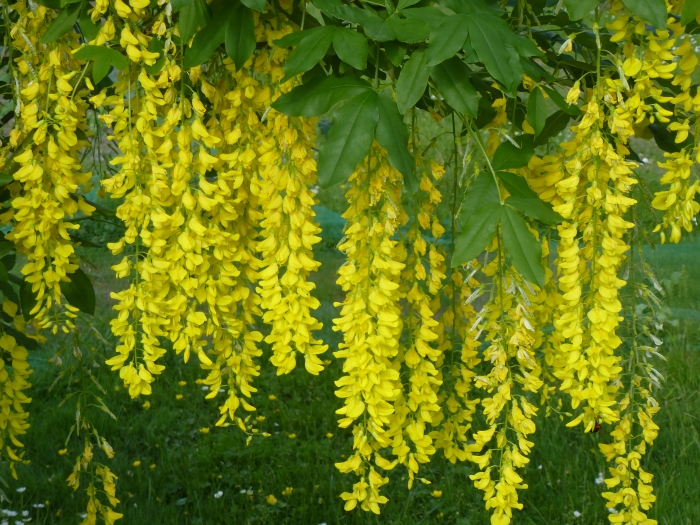Golden Chain Tree
(Laburnum ×watereri)
Golden Chain Tree (Laburnum ×watereri)
/
/

Salix
CC BY-SA 4.0
Image By:
Salix
Recorded By:
Copyright:
CC BY-SA 4.0
Copyright Notice:
Photo by: Salix | License Type: CC BY-SA 4.0 | License URL: https://creativecommons.org/licenses/by-sa/4.0 | Uploader: Salix | Publisher: Wikimedia Commons | Title: Laburnum_x_watereri_in_Jardin_des_Plantes_de_Paris_02.jpg | Notes: User created page with UploadWizard |




























Estimated Native Range
Summary
Laburnum ×watereri, commonly known as Golden Chain Tree, is a small deciduous tree or large shrub that is a naturally occurring hybrid native to central Europe, resulting from the cross of Laburnum alpinum and Laburnum anagyroides. It is typically found in open woodlands and forest edges. The Golden Chain Tree grows to about 8 meters (26 feet) tall and broad, with a notable display of hanging clusters of bright yellow pea-like blossoms in the spring, which are highly ornamental and showy. The flowers hang in pendent racemes up to 60 cm (24 inches) long. It has green foliage that provides a nice backdrop to the flowers, and the bark is generally smooth and gray-brown.
The Golden Chain Tree is valued for its stunning floral display and is often used in gardens for creating focal points or for training into special forms such as arches and espaliers. It is also suitable for urban planting due to its moderate size. This tree prefers a position in full sun to part shade and requires medium amounts of water, thriving in well-drained soils. The cultivar ’Vossii’ is particularly popular for its abundant flowering and has received the Royal Horticultural Society’s Award of Garden Merit. However, all parts of the plant are highly toxic if ingested, and it can suffer from leaf spot and twig blight diseases. It is also important to note that the seeds can be invasive if not controlled.CC BY-SA 4.0
The Golden Chain Tree is valued for its stunning floral display and is often used in gardens for creating focal points or for training into special forms such as arches and espaliers. It is also suitable for urban planting due to its moderate size. This tree prefers a position in full sun to part shade and requires medium amounts of water, thriving in well-drained soils. The cultivar ’Vossii’ is particularly popular for its abundant flowering and has received the Royal Horticultural Society’s Award of Garden Merit. However, all parts of the plant are highly toxic if ingested, and it can suffer from leaf spot and twig blight diseases. It is also important to note that the seeds can be invasive if not controlled.CC BY-SA 4.0
Plant Description
- Plant Type: Tree
- Height: 15-30 feet
- Width: 15-30 feet
- Growth Rate: Moderate
- Flower Color: Yellow
- Flowering Season: Spring, Summer
- Leaf Retention: Deciduous
Growth Requirements
- Sun: Full Sun, Part Shade
- Water: Medium
- Drainage: Medium
Common Uses
Bee Garden, Butterfly Garden, Deer Resistant, Fragrant, Low Maintenance, Rabbit Resistant, Salt Tolerant, Showy Flowers
Natural Habitat
Open woodlands and forest edges
Other Names
Common Names: Golden-Chaintree , Bean Tree , Hybrid-Goldregen , Cytise De Voss , Hybridgullregn
Scientific Names: Laburnum ×watereri , Cytisus ×watereri , Laburnum ×vossii , Laburnum xwatereri , Laburnum ×intermedium , Laburnum alpinum × anagyroides , Laburnum vulgare f. vossii , Laburnum vulgare var. parkesii , Laburnum vulgare var. watereri
GBIF Accepted Name: Laburnum ×watereri (A.C.Rosenthal & Bermann) Dippel